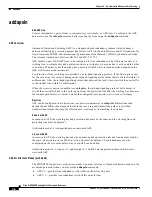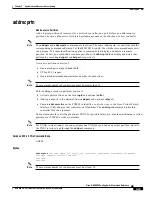
3-6
Cisco MGX 8850 Routing Switch Command Reference
Release 2.0, Part Number 78-10467-04 Rev C0, October 2001
Chapter 3
Equipment and Resource Provisioning
addapsln
addapsln
Add APS Line
Creates (designates) a pair of lines (workingIndex, protectIndex) as APS lines. To configure the APS
parameters, use the cnfapsln command after creating the lines using the addapsln command.
APS Overview
Automatic Protection Switching (APS) is a standards-based redundancy scheme which enhances
network reliability by protecting against line failure. APS is defined in Bellcore and ITU standards for
North American SONET and international Synchronous Data Hierarchy (SDH) optical network links.
The relevant standards are Bellcore GR-253 and ITU-T G.783.
APS enables a pair of SONET lines to be configured for line redundancy. The APS pair consists of a
working line (workingIndex) and a protection line (protectIndex), where one line is active and the other
is a backup. Whether or not the backup line passes real traffic while in standby mode depends on the
APS architecture mode (archmode).
Coordination of line switching is controlled by an in-band signaling protocol. If the fiber optic carrier
for the active line is severed or damaged, the in-band signaling protocol must detect the fault within 10
milliseconds. After the in-band signaling protocol has detected the fault, it must switch the user traffic
to the standby line within 50 milliseconds.
When the revertive option is enabled (see cnfapsln), the in-band signaling protocol will attempt to
switch the user traffic back to the working line from the protection line after the working line becomes
functional again. However, it must wait for the configured time period (wait to restore) to elapse.
Direction
APS can be configured in two directions (see direction parameter in cnfapsln), bidirectional and
unidirectional. Bidirectional means that both the receiving and transmitting paths are switched.
Unidirectional means that only the affected path, receiving or transmitting, is switched.
Same-card APS
In same-card APS, the working bay and protection bay must be the same, and the working line and
protection line must be adjacent.
Architecture mode 1:1 is supported only on same-card APS.
Cross-card APS
In cross-card APS, the working bay and line number, and the protection bay and line number must be
the same. The working slot and the protection slot must be adjacent. Card redundancy must be
configured on the two cards before cross-card APS can be added.
Architecture modes 1+1, Annex 1+1, and Straight 1+1 Nok1k2 are supported on same-card as well as
cross-card APS.
APS Architecture Modes (
archmode
)
The MGX 8850 supports two architecture modes. You must select one of these architecture modes in the
archmode parameter when you execute the addapsln command.
•
APS 1:1—provides line redundancy with traffic on the active line only
•
APS 1+1—provides line redundancy with traffic on both lines
















































